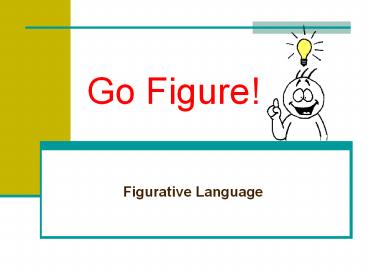Go Figure! PowerPoint PPT Presentation
Title: Go Figure!
1
Go Figure!
- Figurative Language
2
Recognizing Figurative Language
- The opposite of literal language is figurative
language. Figurative language is language that
means more than what it says on the surface. - It usually gives us a feeling about its subject.
- Authors and poets use figurative language almost
as frequently as literal language. When you read,
you must be conscious of the difference.
Otherwise, a text may make no sense at all.
3
Recognizing Literal Language
- Ive eaten so much I feel as if I could
literally burst! - In this case, the person is not using the word
literally in its true meaning. Literal means
"exact" or "not exaggerated." By pretending that
the statement is not exaggerated, the person
stresses how much he has eaten. - Literal language is language that means exactly
what is said. - Most of the time, we use
- literal language.
4
What is figurative language?
- Whenever you describe something by comparing it
with something else, you are using figurative
language.
5
Types of Figurative Language
- Imagery
- Simile
- Metaphor
- Alliteration
- Personification
- Onomatopoeia
- Hyperbole
- Idioms
6
Alliteration
- Repeated consonant sounds occurring at the
beginning of words or within words. - Example She was wide-eyed and wondering while
she waited for Walter to waken.
7
Allusion
- An allusion is a reference to a famous person,
place, event, or work of literature. It is
something that is in most cases widely known by
all people.
- Example He ran the race but lost despite his
Herculean effort.
8
Dialect
- A dialect is a form of language that is spoken in
a certain place or by a certain group of people.
Dialects may differ in pronunciation, vocabulary,
and grammar.
- Example Yesm. I reckon thats what I should
do.
9
Flashback
- A flashback is an interruption of the action to
present a scene that took place at an earlier
time.
- Example As soon as I saw the trophy my mind was
transported back to a younger time. I wasnt an
old man. I was young and had just won that award
for
10
Foreshadowing
- Foreshadowing is when an author provides clues or
hints that suggest future events.
- Example Charlotte took the dirk that Zachariah
gave her and put it under her mattress. She
hoped she wouldnt need to think of it again, but
alas, that would not be the case.
11
Hyperbole
- An exaggerated statement used to heighten effect.
It is not used to mislead the reader, but to
emphasize a point. - Example Shes said so on several million
occasions.
12
Imagery
- Language that appeals to the senses. Descriptions
of people or objects stated in terms of our
senses.
Sight Hearing Touch Taste Smell
13
Metaphor
- A figure of speech which involves an implied
comparison between two relatively unlike things
using a form of be. The comparison is not
announced by like or as. - Example The road was a ribbon wrapped through
the dessert.
14
Onomatopoeia
- The use of words that mimic sounds.
- Example The firecracker made a loud ka-boom!
15
Personification
- A figure of speech which gives the qualities of a
person to an animal, an object, or an idea. - Example The wind yells while blowing."
- The wind cannot yell. Only a living thing can
yell.
16
Simile
- A figure of speech which involves a direct
comparison between two unlike things, usually
with the words like or as. - Example The muscles on his brawny arms are
strong as iron bands.
17
Symbolism
- A symbol or symbolism is a person, place, object
or an action that stands for something beyond
itself.
18
Repetition
- Repetition is the use of any element of
languagea sound, word, phrase---more than once
to stress a certain idea.
- Example The highwayman came riding, riding,
riding, - the highwayman came riding up to the old inn
door.
19
Idioms
- An idiom or idiomatic expression refers to a
construction or expression in one language that
cannot be matched or directly translated
word-for-word in another language.
- Example "She has a bee in her bonnet," meaning
"she is obsessed," cannot be literally translated
into another language word for word.
20
Figurative Language Resources
- Eye on Idioms (Online PPT)
- Paint by Idioms (Game)
- Alliteration or Simile? (Quiz)
- Similes and Metaphors (PPT)
- The Search for Similes, Metaphors, and Idioms
(PPT) - Alliteration (PPT)
- Onomatopoeia (PPT)
- Personification (PPT)
- Hyperbole (PPT)
- Idioms (PPT)
- Simile (PPT)
21
Teaching Similes and Metaphors
- Alliteration Lesson Plan and Resources
http//volweb.utk.edu/Schools/bedford/harrisms/1al
litera.htm - Hyperbole- Lesson Plans and Resources
http//volweb.utk.edu/Schools/bedford/harrisms/10l
esson.htm - Idiom Lesson Plan http//volweb.utk.edu/Schools/be
dford/harrisms/6lesson.htm - Imagery- Lesson Plans and Resources
http//volweb.utk.edu/Schools/bedford/harrisms/ima
gery2.htm - Lesson Plan for Puns http//volweb.utk.edu/Schools
/bedford/harrisms/5lesson.htm - Onomatopoeia- Lesson Plans and Resources
http//volweb.utk.edu/Schools/bedford/harrisms/9le
sson.htm - Personification Lesson Plans and Resources
- http//volweb.utk.edu/Schools/bedford/harrisms/7le
sson.htm - Proverbs- Lesson Plans and Resources
http//volweb.utk.edu/Schools/bedford/harrisms/pro
verbs2.htm

